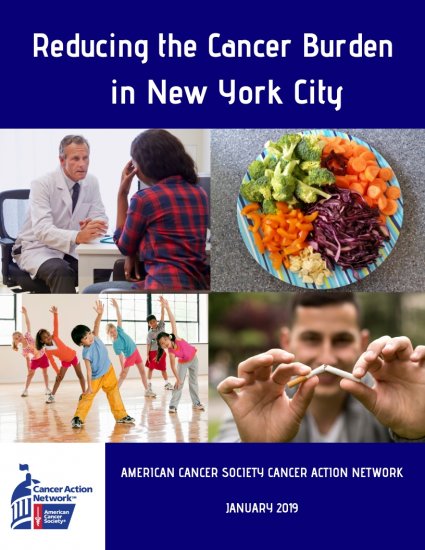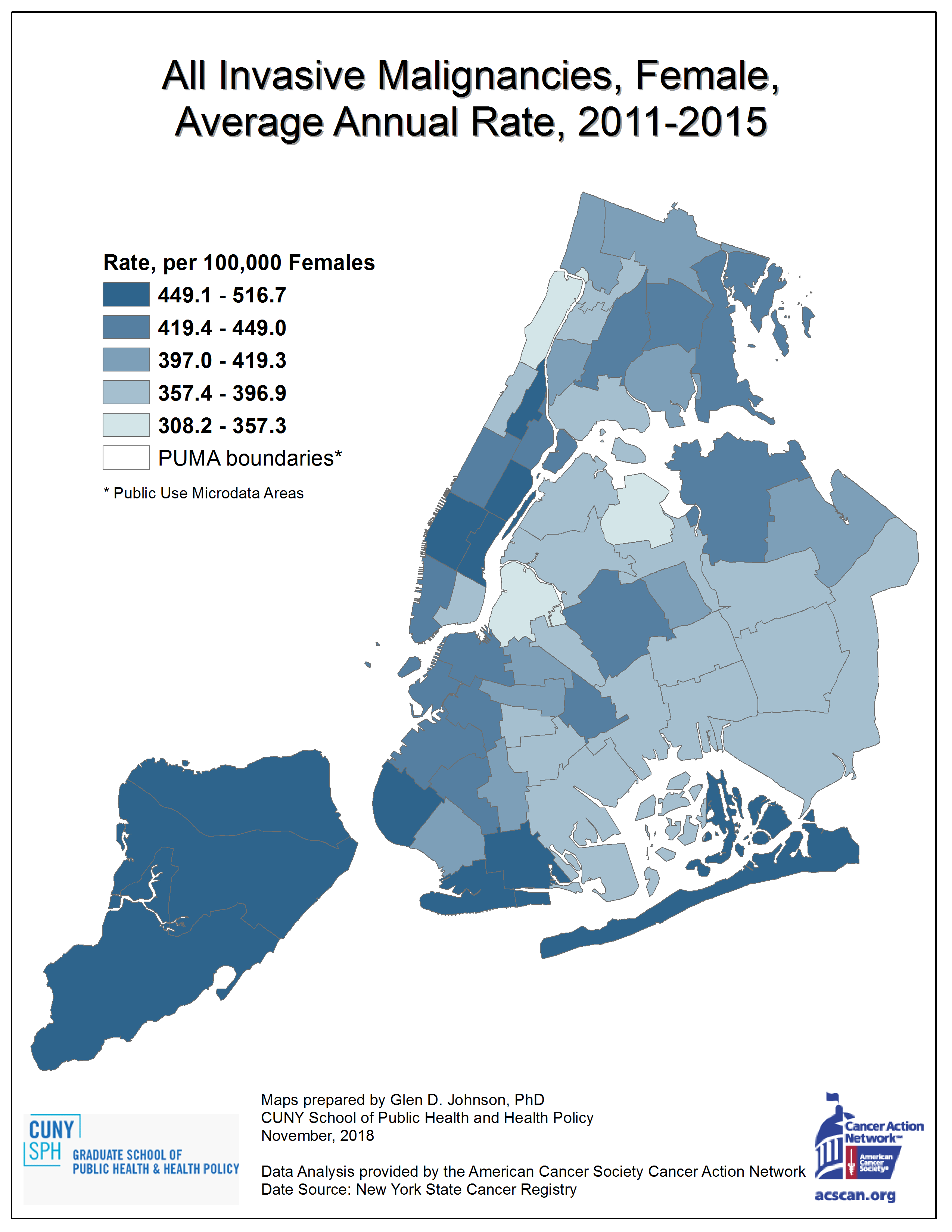New ACS CAN report takes an in-depth look at the state of cancer in New York City.
40,126 New York City residents were diagnosed with cancer annually between 2011-15

NEW YORK--February 14, 2019--So many people are diagnosed with cancer every year in New York City that they could fill Madison Square Garden, twice—40,126. That’s according to our report “Reducing the Cancer Burden in New York City.”
Cancer cases and cancer deaths differ greatly among boroughs and the neighborhoods making up New York City, in part reflecting the diverse socioeconomic and demographic characteristics across New York City.
Nearly every New Yorker from every neighborhood has been touched by cancer in some way. This report demonstrates that we know how to reduce the cancer burden in New York City if only we have the will to do so.
Questions?
Contact Michael Davoli at 212-237-3853 or by email [email protected].
PLEASE NOTE: A minor error was found in the Queens and Staten Island borough profiles located in the appendix of the report. The error has been corrected. Please download the revised borough profiles below. The complete report has been fixed as well to address this error. (Updated May 13, 2019)
Download the complete report here (PDF)
Download report press release here (PDF)
Download the borough profiles here (PDF)
Download high-resolution cancer maps here (PDF)
Download high-resolution cancer maps by PUMA neighborhood here (PNG)
Download high-resolution cancer maps by New York City Council district here (PNG)
Download complete neighborhood data with explanation
Key Findings Include:
-
On average, approximately 40,126 New York City residents were diagnosed with cancer annually between 2011-2015, with 12,453 dying from the disease annually during this period.
-
On average, approximately 771 New York City residents were diagnosed with cancer and 241 individuals died from cancer each week from 2011-2015.
-
The number of people diagnosed with cancer annually from 2011-2015 on average was nearly twice the capacity of Madison Square Garden.
-
Four cancers - lung, prostate, breast and colorectal - account for nearly half (47.4 percent) of all cancer diagnoses and nearly half (45 percent) of all cancer deaths in New York City from 2011-2015.
-
Lung and bronchus cancer is the single largest cause of cancer death, causing nearly 2668 deaths yearly from 2011-2015. Colorectal (1,240), female breast (1,027), and Pancreatic (933) cancers were the second, third and fourth most frequent causes of mortality.
-
Female breast cancer is New York City's most commonly diagnosed cancer among women, with 5,887 women diagnosed annually between 2011-15, whereas prostate cancer was the most common among men (5,347 new cases annually from 2011-2015).
-
Lung and bronchus cancer is New York City's most common cause of cancer death among women, with 1237 women cancer deaths caused annually between 2011-15, and men (1430 deaths annually from 2011-2015).
-
Men and women living on Staten Island have the highest incidence rate of new cancer cases overall on average annually between 2011-2015.
-
Men and women on Staten Island experience the highest rates of lung and bronchus cancer.
-
Women in Manhattan and men in the Bronx have the highest rates of female breast and prostate cancer respectively on average annually between 2011-2015.
-
Men living in PUMA “Neighborhoods” Morris Heights, Fordham South and Mount Hope (#3707), Brownsville & Ocean Hill (#4007), and Tottenville, Great Kills and Annadale (#3901) have the approximate highest cancer incidence rate overall among men. (See page 15 for the definition of PUMA Neighborhoods)
-
Men living in PUMA “Neighborhoods” Jackson Heights and North Corona (#4102), Sunnyside & Woodside (#4109), and Greenpoint and Williamsburg have the approximate lowest cancer incidence rate overall among men. (See page 15 for the definition of PUMA Neighborhoods)
-
Women living in PUMA “Neighborhoods” Tottenville, Great Kills and Annadale (#3901), New Springville and South Beach (#3902), and Bay Ridge and Dyker Heights (#4013) have the approximate highest cancer incidence rate overall among women. (See page 15 for the definition of PUMA Neighborhoods)
-
Women living in PUMA “Neighborhoods” Greenpoint and Williamsburg (#4001), Jackson Heights and North Corona (#4102) and Washington Heights, Inwood and Marble Hill (#3801) have the approximate lowest cancer incidence rate overall among women. (See page 15 for the definition of PUMA Neighborhoods)
-
Non-Hispanic Whites have the highest rate, 510 cancer cases per 100,000 males and females, of all cancers on average annually between 2011-2015.
-
Non-Hispanic Blacks have the highest cancer death rate, 167 cancer deaths per 100,000 males and females, of all cancers on average annually between 2011-2015.
-
Citywide, only 40.9 percent of colorectal cancer diagnosed in men and 40.8 percent of colorectal cancer diagnosed in women are detected at an early stage on average annually between 2011-2015.
-
Citywide, only 44 percent of cervical cancer diagnosed in women are detected at an early stage on average annually between 2011-2015.
-
Citywide, only 21.6 percent of lung and bronchus cancer diagnosed in men and 28.3 percent of lung and bronchus cancer diagnosed in women are detected at an early stage on average annually between 2011-2015.
-
About 30 percent of all cancer deaths are caused by cigarette smoking.
-
The combined effects of excess body weight, poor diet, alcohol consumption, and physical inactivity are associated with 18 percent of all cancer cases.
-
Certain cancers caused by infectious agents, such as the human papillomavirus (HPV), could be prevented through vaccination.
ACS CAN Recommendations Include:
Recommendations for reducing tobacco use:
-
Increase funding for tobacco control and cessation programs at the New York City DOHMH from $7.2 million to $11.2 million annually with the additional revenue going toward developing a targeted campaign focused on communities with the highest smoking rates. With additional revenue the DOHMH could:
-
Identify people who use tobacco and who would like to quit and connect them with local cessation services;
-
Provide FDA approved cessation treatments; and
-
Fund promotion of the New York State Quit Line and local support services to populations where smoking rates continue to be the highest.
-
-
Earmark a substantial portion of the revenue generated by the City’s 10 percent tax on non-cigarette tobacco products to conduct a smoking cessation program at the New York City Housing Authority in partnership with the DOHMH.
-
Restrict the sale of all flavored tobacco products including menthol and electronic cigarettes.
-
Require all college and university campuses to be tobacco-free, including the use of electronic cigarettes.
Recommendations for reducing obesity:
-
Ensure that the four-year, $385 million capital funding commitment included in the New York City Budget adopted in June 2017 is fulfilled and that all schools have a dedicated space for physical education by 2021.
-
Baseline $5 million to the New York City Department of Education for the hiring of full-time certified physical education teachers and support staff to ensure that the progress of recent years continues.
-
Strengthen the 2015 New York City physical education in schools reporting law to require the Department of Education to:
-
Post all physical education reporting information on individual school websites;
-
Notify all parents of the availability of the new information;
-
Post the data in a manner searchable by individual school, school district, and borough;
-
Include details on whether there is designated space for physical education instruction, a designated gym space to support the minimum amount of physical activity required of students by law; and
-
Include details on the number of certified teachers on a school level
-
-
Provide a new $30 million annual allocation to the DOHMH for new obesity prevention programming. The money should be used as follows:
-
$2 million to fund and coordinate evidence-based city level childhood obesity prevention activities including parental education;
-
$3 million to establish a healthy corner store initiative to help existing corner stores offer healthier food options to their customers;
-
$10 million to create a Healthy Food Financing Initiative (HFFI) to help food establishments open, expand, and improve in neighborhoods that need food and jobs the most; and
-
$15 million to expand Supplemental Nutrition Assistance Program (SNAP) incentives such as Health Bucks so more New Yorkers can immediately afford fresh fruits and vegetables.
-
-
Establish a tax of at least two cents per ounce on all sugary drinks and dedicate the revenue to obesity prevention programming like those included above.
-
Restrict the sale of sugary drinks at public parks, beaches and in schools, including at school events.
-
Require healthy eating options on kids’ menus in restaurants including ensuring that menu items targeting youth do not include sugary drinks.
-
Strengthen current nutrition standards for all foods and beverages sold, served, or marketed in schools, before, during and after regular school hours.
-
Strengthen current nutrition standards for all foods and beverages sold, served, or marketed in government buildings and other public service venues to increase access to healthy options.
-
Establish zoning rules to promote access to healthy foods.
-
Conduct a detailed review of streets and sidewalks to ensure that they enable safe walking, running, bicycling and other forms of physical activity.
Recommendations for preventing cancer and increasing rates of early detection:
-
Provide a $3.85 million annual allocation to the DOHMH for cancer prevention programming. The money should be used as follows:
-
$2.7 million annually should go toward cancer prevention patient navigation programming;
-
The NYU Langone Perlmutter Cancer Center is currently in the final year of a $1.35 million annual allocation from the DOHMH; Increasing the amount to $2.7 million annually will allow for the program to help more people in medically underserved areas of New York City access screening for colorectal cancer and breast cancer, regardless of their income or insurance status.
-
-
$500,000 to the to expand the New York City Community Cares Project;
-
$150,000 to cover the transportation costs of patients that are identified through the New York City Community Cares Project; and
-
$500,000 for a health care provider and parent education campaign aimed at increasing Human papillomavirus (HPV) vaccination rates.
-
-
Establish a cancer screening registry that maintains colon, breast, cervical, and lung and bronchus cancer screening records for New York City residents and allocate an appropriate level of funding for its implementation.
-
Ensure that there is at least one endoscopy center open in each borough care provider and parental education programming on the importance of the HPV vaccine.
-
Provide $350,000 to the New York City Parks Department for a citywide program to provide to free sunscreen at all New York City parks, pools and beaches.
Recommendations for promoting cancer research:
-
Establish a New York City Commission on Cancer Research (NYCCCR) to promote significant and original research in New York City into the causes, prevention, treatment and palliation of cancer and serve as a resource to providers and consumers of cancer services. New York City should appropriate $5 million annually to the Commission.
-
Contribute $5 million annually to the New York Fund for Innovation in Research and Scientific Talent (NYFIRST) to bring top scientific talent to New York City’s leading medical schools, teaching hospitals and cancer research centers.
